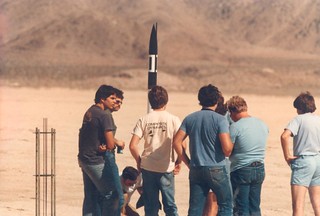
That's me at roughly 12 or 13 years old proudly sporting tethered, fold-up Vuarnet sunglasses; one of two pairs my grandmother had generously purchased for me on her vacation in France. Note also the custom-built Aerotech fanboy shirt with velvet, iron-on lettering. On the back I had made an attempt to run a popular slogan of the time: "Aerotech Gets High On NH4CLO4" and yes that's a capital L. Gary Rosenfield expressed confusion when he first saw my shirt and, in short order, having mentally inventoried the periodic table of the elements, was unable to recall this "L"ement. He was kind about it but, as a chemical engineer now, just know that I'm cringing and yes it should have read NH4ClO4. Duh.
I think that rocket was about 2.5" in diameter and ~5' tall and I called it Gaudior having recently read Madeleine L'Engle's A Swiftly Tilting Planet. I was having trouble with the motor mount diameters just now until The Google turned up this Canadian Crown Rocket Technologies (CRT) catalog [and check out the cornucopia of other retro gems on his site!]. The central motor was a 29mm F67 and the three outboard pods with individual nosecones held CRT 24mm E45 motors (with ejection charges removed). At the time the ignition method du jour for clusters involved sleeved Thermalite Fuse rigs with flashbulb initiators hence the disconcerting business end. Despite a slightly angled liftoff I was convinced the flight had gone as planned. Upon recovery, however, I observed that two of the E45s had CATO'd just after liftoff so I was a semi-sad kid that day and I don't think I rebuilt Gaudior. Damned bleeding edge rocket science! :) Oh and I used to paint all my rockets so I've only become lazy on finishing in the last decade or so.
Next up is Jim Jaworski prepping with a group of early high-power flyers in deep conversation

I'm at far left, Gary Rosenfield can be seen just behind me, Jim Jaworski is on the ground setting up his igniter, Jerry Irvine has his back to the camera, and I don't remember the other four fellas on the right. Despite Jerry's infamy in recent decades I always found him to be an extremely intelligent and thoughtful rocketry mentor and a good friend.
Now onto the flight... Jim Jaworski was in/famous for his beautifully built and finished rockets that pushed the total impulse boundaries beyond most of the group but, unfortunately, they often failed in some new way. I'm quite certain this was a J- or K-class ~2" motor with low initial thrust typical of case-bonded, progressive burn geometries of the day. Upon ignition the motor mega-chuffed the rocket off the rod then it laid horizontally on the ground awaiting additional chuffs and eventual ignition. Upon final pressure-up it then shot out horizontally across the desert in spectacularly undesirable fashion. Nobody was hurt and Jim recovered the rubble. We've come a long way with BATES grains and peak thrusts in the beginning with nice regressive traces that don't shred rockets. Someone must suffer these learning setbacks to advance our collective knowledge so... thanks, Jim!
I should note that Aerotech was already employing an early BATES grain precursor where they cast propellant into a cardboard tube. Once core-drilled this "cartridge" of propellant was dropped into the phenolic liner with glass-phenolic nozzle and the forward end sealed up with delay and ejection charge. As such AT motors were bleeding edge and featured end- as well as core-burning geometry. This gave them a nice initial kick off the pad but the high aspect ratio of the cartridge produced a humped thrust trace that wasn't quite the ideal regressive burn yet. Anyway kudos to Gary!


